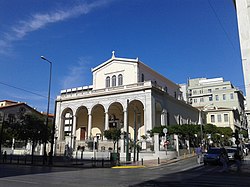| Catholic Church in Greece | |
|---|---|
| Greek: Καθολική Εκκλησία στην Ελλάδα | |
 | |
| Type | National polity |
| Classification | Catholic |
| Governance | Catholic Bishops' Conference of Greece |
| Pope | Francis |
| Apostolic Nuncio | Savio Hon |
| Region | Greece |
| Language | Latin Greek |
| Founder | Apostles Andrew and Paul |
| Origin | 1st century |
| Part of a series on the |
| Catholic Church by country |
|---|
 |
|
|
The Catholic Church in Greece is part of the worldwide Catholic Church, under the spiritual leadership of the Pope in Rome. Indigenous Roman Catholic Greeks numbered about 50,000-70,000 in 2022[1] and were a religious and not an ethnic minority. Most of them are a remnant of Venetian and Genoese rule in southern Greece and many Greek islands (in both the Aegean and Ionian seas) from the early 13th until the late 18th century, Greeks who converted to Catholicism or descendants of the thousands of Bavarians that came to Greece in the 1830s as soldiers and civil administrators, accompanying King Otto. One very old but still common term to reference to them is Φράγκοι, or "Franks", dating to the times of the Byzantine Empire, when medieval Greeks would use that term to describe all Catholics.
Since the early 1990s however, the number of Catholic permanent residents of Greece has greatly increased; as of 2002, they numbered 200,000 at the very least, and probably more.[1] These Catholics are immigrants from Eastern Europe (especially Poland) or from the Philippines, but also include Western European immigrants that live permanently in Athens, Thessaloniki or the Greek islands (especially Crete, Syros, Rhodes and Corfu).
Today, the majority of Catholics live in Athens, a city of about four million people; the rest of them can be found all over Greece. Most indigenous Catholics live in the islands, and especially the Cyclades, where Syros and Tinos in particular have some entirely Catholic villages and parishes. Catholics can be found also in Corfu, Naxos, Santorini, Kefalonia, Zakynthos, Rhodes, Kos, Crete, Samos, Lesbos and Chios. In the mainland, Catholic communities are smaller, and include those of Patras (a city that was home to a large Italian community until World War II), Thessaloniki, Kavala, Volos etc. In addition to Roman Catholics who represent the vast majority of the faithful, there were about 5,000 members of the Greek Byzantine Catholic Church[1] and a few hundred Armenian Catholics in 2002.
The Catholic Church itself states that "the total population of Catholics in Greece exceeds 350,000".[2] Other estimates suggested that there were 133,000 Catholics in Greece (1.22% of the population) in 2020.[3]
The Catholic Church is recognised by the Greek government and Catholic schools operate in the country.[4]
- ^ a b c "Religious Freedom in Greece (September2002)". Greek Helsinki Monitor Minority Rights Group - Greece. Archived from the original (RTF) on 2007-09-29. Retrieved 2007-09-15.
- ^ Catholic Church in Greece website, retrieved 2023-13-10
- ^ Catholics and Culture website, retrieved 2023-08-08
- ^ US State Dept 2022 report